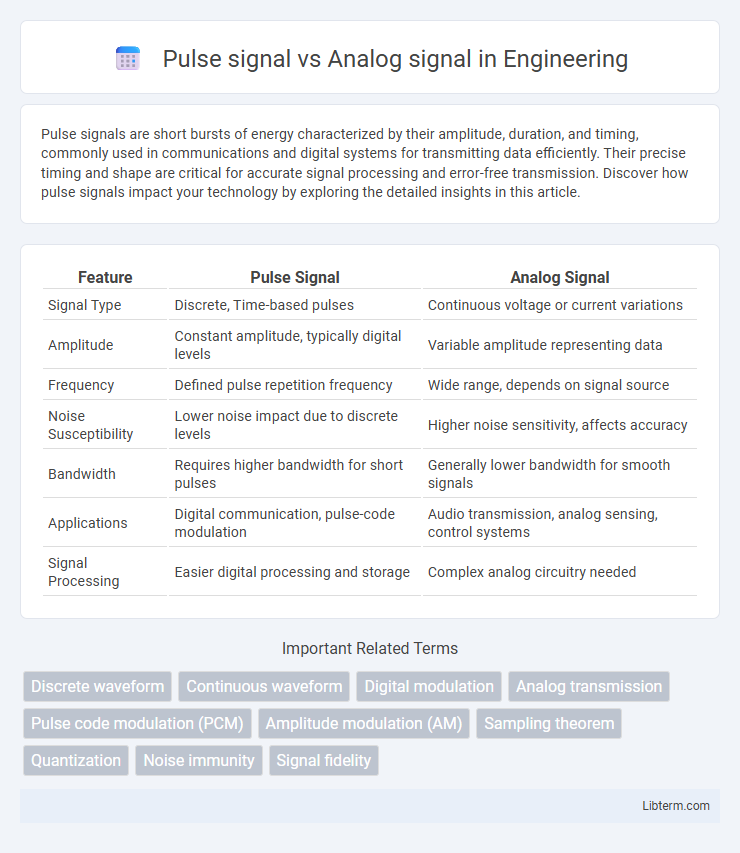Pulse signals are short bursts of energy characterized by their amplitude, duration, and timing, commonly used in communications and digital systems for transmitting data efficiently. Their precise timing and shape are critical for accurate signal processing and error-free transmission. Discover how pulse signals impact your technology by exploring the detailed insights in this article.
Table of Comparison
| Feature | Pulse Signal | Analog Signal |
|---|---|---|
| Signal Type | Discrete, Time-based pulses | Continuous voltage or current variations |
| Amplitude | Constant amplitude, typically digital levels | Variable amplitude representing data |
| Frequency | Defined pulse repetition frequency | Wide range, depends on signal source |
| Noise Susceptibility | Lower noise impact due to discrete levels | Higher noise sensitivity, affects accuracy |
| Bandwidth | Requires higher bandwidth for short pulses | Generally lower bandwidth for smooth signals |
| Applications | Digital communication, pulse-code modulation | Audio transmission, analog sensing, control systems |
| Signal Processing | Easier digital processing and storage | Complex analog circuitry needed |
Introduction to Pulse and Analog Signals
Pulse signals are discrete-time signals characterized by sudden changes in amplitude, often used in digital communication and control systems due to their clear distinction between high and low states. Analog signals vary continuously over time, representing physical quantities such as temperature, sound, or light intensity, making them fundamental in traditional audio and sensor applications. Understanding the differences in waveform continuity and data representation between pulse and analog signals is essential for designing efficient electronic and communication systems.
Definition of Pulse Signal
A pulse signal is a type of electrical signal characterized by abrupt changes between discrete voltage levels, typically switching between a high and low state, used to represent digital data or timing information. Unlike an analog signal, which varies continuously over time to represent information, a pulse signal consists of short bursts or pulses that convey information in a binary format. Pulse signals are essential in digital electronics, communication systems, and pulse-code modulation for encoding and transmitting data efficiently.
Definition of Analog Signal
An analog signal is a continuous waveform that represents variations in physical quantities such as sound, light, or temperature, allowing infinite values within a range. It differs from a pulse signal, which consists of discrete time intervals with distinct high and low states, commonly used in digital communications and switching systems. The continuous nature of analog signals enables precise representation of real-world phenomena, but also makes them more susceptible to noise and distortion compared to pulse signals.
Key Characteristics of Pulse Signals
Pulse signals are characterized by discrete, non-continuous values that switch between on and off states, making them essential in digital communications and timing applications. These signals exhibit rapid transitions, well-defined amplitude levels, and precise timing intervals, which enhance noise immunity and enable accurate data representation. Unlike analog signals, pulse signals maintain consistent amplitude throughout each pulse, allowing for easier signal processing and reduced distortion.
Key Characteristics of Analog Signals
Analog signals exhibit continuous variation in amplitude and frequency, representing real-world phenomena with infinite resolution within their range. They can take any value within a specified bandwidth, allowing smooth transitions and detailed information encoding. Unlike discrete pulse signals, analog signals are more susceptible to noise and distortion but offer higher fidelity in capturing natural variations.
Differences Between Pulse and Analog Signals
Pulse signals consist of discrete, non-continuous values represented by distinct pulses, while analog signals are continuous waveforms that vary smoothly over time. Pulse signals are primarily digital and can easily resist noise, making them suitable for digital communication systems, whereas analog signals are more susceptible to noise and distortion. Additionally, pulse signals enable precise timing and synchronization, whereas analog signals provide a more accurate representation of varying physical phenomena.
Applications of Pulse Signals
Pulse signals are widely used in digital communications, radar systems, and medical imaging such as ultrasound due to their ability to represent discrete data and resist noise. In control systems, pulse signals facilitate precise timing and switching operations essential for automation and signal processing. Their applications extend to clock generation in electronics and pulse-width modulation in motor control, offering efficient energy use and signal clarity.
Applications of Analog Signals
Analog signals are extensively used in audio and video transmission, enabling natural sound and image reproduction in devices like microphones, televisions, and radios. They also play a critical role in sensor technology, capturing continuous data from physical phenomena such as temperature, pressure, and light intensity for industrial and scientific applications. Medical equipment, including electrocardiograms (ECGs) and analog oscilloscopes, rely on analog signals to monitor and analyze continuous physiological parameters accurately.
Advantages and Disadvantages
Pulse signals offer advantages such as better noise immunity and easier digital processing compared to analog signals, which are more susceptible to distortion and interference. Analog signals provide continuous data representation, enabling higher resolution for smooth waveform reproduction but can degrade over distance without amplification. Pulse signals require less bandwidth and allow for efficient error detection, while analog signals are simpler to implement in systems where signal fidelity is critical.
Summary and Future Trends
Pulse signals offer discrete on/off states ideal for digital communication and high-speed data processing, while analog signals provide continuous representations essential for natural phenomena and traditional audio transmission. Emerging technologies emphasize integrating pulse signal advantages with analog signal fidelity through hybrid modulation and advanced signal processing algorithms. Future trends point toward enhanced energy efficiency, improved noise resilience, and greater adaptability in mixed-signal systems for IoT, 5G, and AI-driven applications.
Pulse signal Infographic

 libterm.com
libterm.com